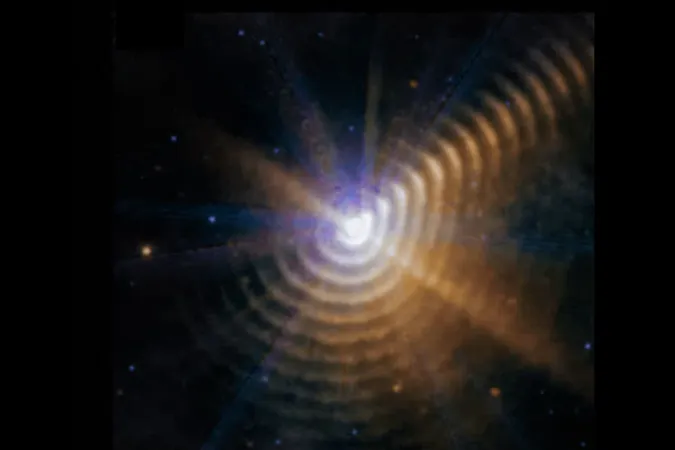
Stunning Webb Telescope Image Reveals 'Shelled' Star on the Brink of Supernova!
2025-01-14
Author: Ling
Stunning Webb Telescope Image Reveals 'Shelled' Star on the Brink of Supernova!
The James Webb Space Telescope has captured an awe-inspiring image of Wolf-Rayet 140, a binary star system located approximately 5,000 light-years from Earth. The system is surrounded by remarkable concentric rings of dust, reminiscent of a tree's growth rings but on a cosmic scale. This groundbreaking image confirms the existence of these dust rings, providing new insights into the processes that distribute essential elements, such as carbon, throughout the universe.
In a recent study published in The Astrophysical Journal Letters, astronomers discussed their findings during the 245th meeting of the American Astronomical Society in National Harbor, Maryland. "The telescope not only confirmed that these dust shells are real, but its data also demonstrated that the dust shells are moving outward at consistent velocities, revealing visible changes over incredibly short periods of time," said Emma Lieb, a researcher at the University of Denver and lead author of the study.
Wolf-Rayet stars, including one in WR 140, are enormous and volatile celestial bodies nearing the end of their life cycles. Typically larger than the sun, these stars lose mass rapidly and are considered progenitors of supernovae. The Wolf-Rayet star in WR 140 alone is about 10 times the mass of our sun. Observations have shown that after such a star dies, it will dramatically expel its outer layers into space in a spectacular supernova explosion.
The Webb Telescope has previously peered into the lives of Wolf-Rayet stars. Earlier in 2023, it captured the breathtaking visuals of WR 124, located approximately 15,000 light-years away. WR 124's gas and dust streams were detected hurtling away from the star at astonishing speeds exceeding 93,200 miles per hour (150,000 kilometers per hour).
Over the past 130 years, WR 140 has released more than 17 dust shells into the cosmos; many have since dissipated beyond detection. Remarkably, the dust shells from WR 140 are expanding at an extraordinary velocity of over 1,600 miles per second (approximately 2,600 kilometers per second), outpacing those of WR 124.
An intriguing animation illustrates the mechanisms behind these dust formations. The interaction between the two stars at the center of WR 140 causes their stellar winds to collide, compressing material into a carbon-rich dust that is then expelled into space. This process occurs approximately once every eight years during their orbital dance, with each ring representing one orbital period.
The Webb Telescope's advanced mid-infrared capabilities were crucial for this analysis due to the relatively cool temperatures of the dust. As study co-author Ryan Lau explained, "Mid-infrared observations allow us to see the dust shells more effectively, providing precise details on when the stars are forming dust, almost down to the day."
The ultimate fate of the Wolf-Rayet star in WR 140 remains a mystery. It could transition into a supernova or collapse into a black hole. If it becomes a black hole, the surrounding dust shells may remain intact; however, a supernova explosion would likely obliterate much of the material.
Regardless of its fate, the Webb Telescope is poised to provide unparalleled insights into the life cycle of stars, including how carbon-rich material is distributed throughout the universe—essential for the formation of new stars and planets. Stay tuned! This cosmic drama is far from over!

 Brasil (PT)
Brasil (PT)
 Canada (EN)
Canada (EN)
 Chile (ES)
Chile (ES)
 Česko (CS)
Česko (CS)
 대한민국 (KO)
대한민국 (KO)
 España (ES)
España (ES)
 France (FR)
France (FR)
 Hong Kong (EN)
Hong Kong (EN)
 Italia (IT)
Italia (IT)
 日本 (JA)
日本 (JA)
 Magyarország (HU)
Magyarország (HU)
 Norge (NO)
Norge (NO)
 Polska (PL)
Polska (PL)
 Schweiz (DE)
Schweiz (DE)
 Singapore (EN)
Singapore (EN)
 Sverige (SV)
Sverige (SV)
 Suomi (FI)
Suomi (FI)
 Türkiye (TR)
Türkiye (TR)
 الإمارات العربية المتحدة (AR)
الإمارات العربية المتحدة (AR)